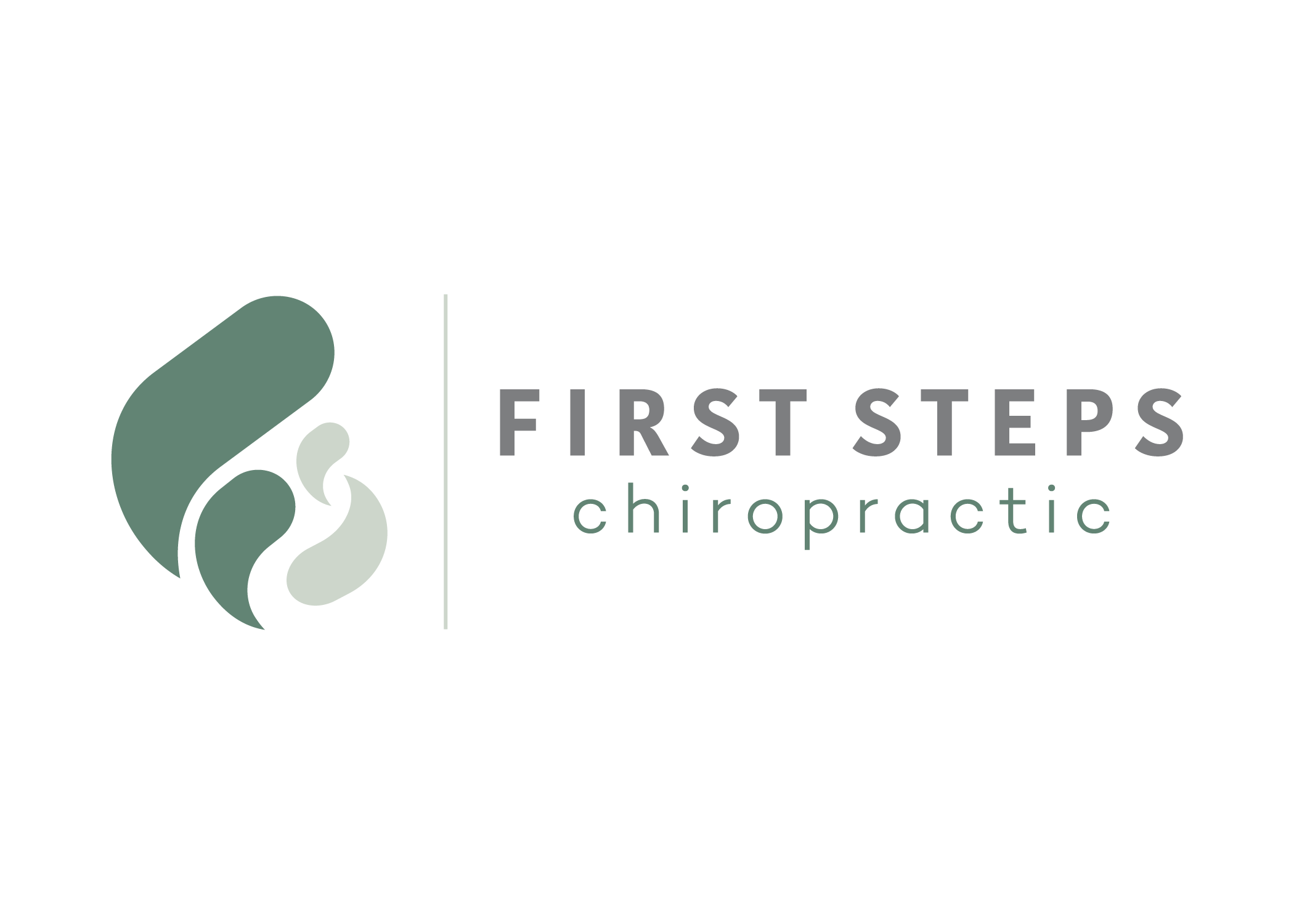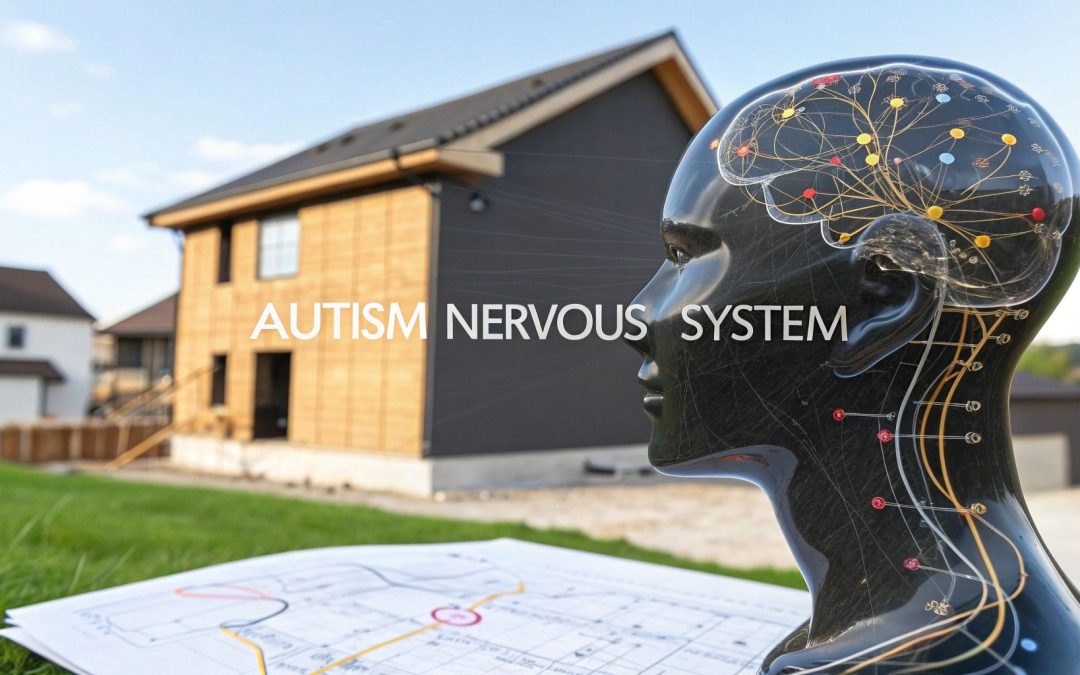At its core, autism is a neurological condition. It’s not about behavior or choices, but about how an individual's brain and nervous system are wired to develop and function from the very beginning. This unique wiring shapes how a person perceives the world, regulates emotions, and interacts with others.
Understanding this fundamental connection is the first step toward providing real, meaningful support.
Connecting Autism to the Nervous System
So, what does it mean to have an "autism nervous system"? Think of it like the electrical wiring in a house. In a neurotypical system, the wiring is standard and functions predictably. In an autistic nervous system, the wiring is custom—it's not broken or faulty, just configured differently.
This custom setup leads to very different sensory and emotional experiences. Imagine a smoke detector so sensitive that it shrieks every time a kettle steams—that’s what heightened sensory input can feel like. On the other hand, a light switch might feel "stuck," making it hard to get a room fully bright, which is a good way to picture a muted or delayed response to the world.
The Two Modes of Operation
Our Autonomic Nervous System (ANS) is the body's autopilot. It manages all the things we don't consciously think about, like our heart rate, breathing, and digestion. It primarily operates in two distinct modes.
To really get this, let's look at the two "gears" of the nervous system side-by-side.
Two States of the Autonomic Nervous System
| Nervous System State | Nickname | Primary Function | Common Experience in Autism |
|---|---|---|---|
| Sympathetic | "Fight-or-Flight" | The body's gas pedal; prepares for action, stress, and threats. | The system is often "stuck" here, leading to constant high alert, anxiety, and sensory overload. |
| Parasympathetic | "Rest-and-Digest" | The body's brake pedal; promotes calm, healing, and recovery. | It can be very difficult to access this state, making it hard to calm down, sleep, and regulate. |
Many autistic individuals find their nervous system is almost constantly stuck in that sympathetic, "fight-or-flight" state. This isn't a choice; it's a physiological reality. Their system is perpetually scanning for threats, which makes daily life feel incredibly overwhelming. This is a critical piece of the puzzle for anyone wanting to achieve better nervous system regulation.
The persistent activation of the sympathetic state explains why sensory inputs, emotional demands, and unexpected changes can feel so intense—the system is already primed for a threat, even when none exists.
This visual gives a great overview of how neural connectivity, sensory processing, and behavioral responses are all linked in the autism nervous system.
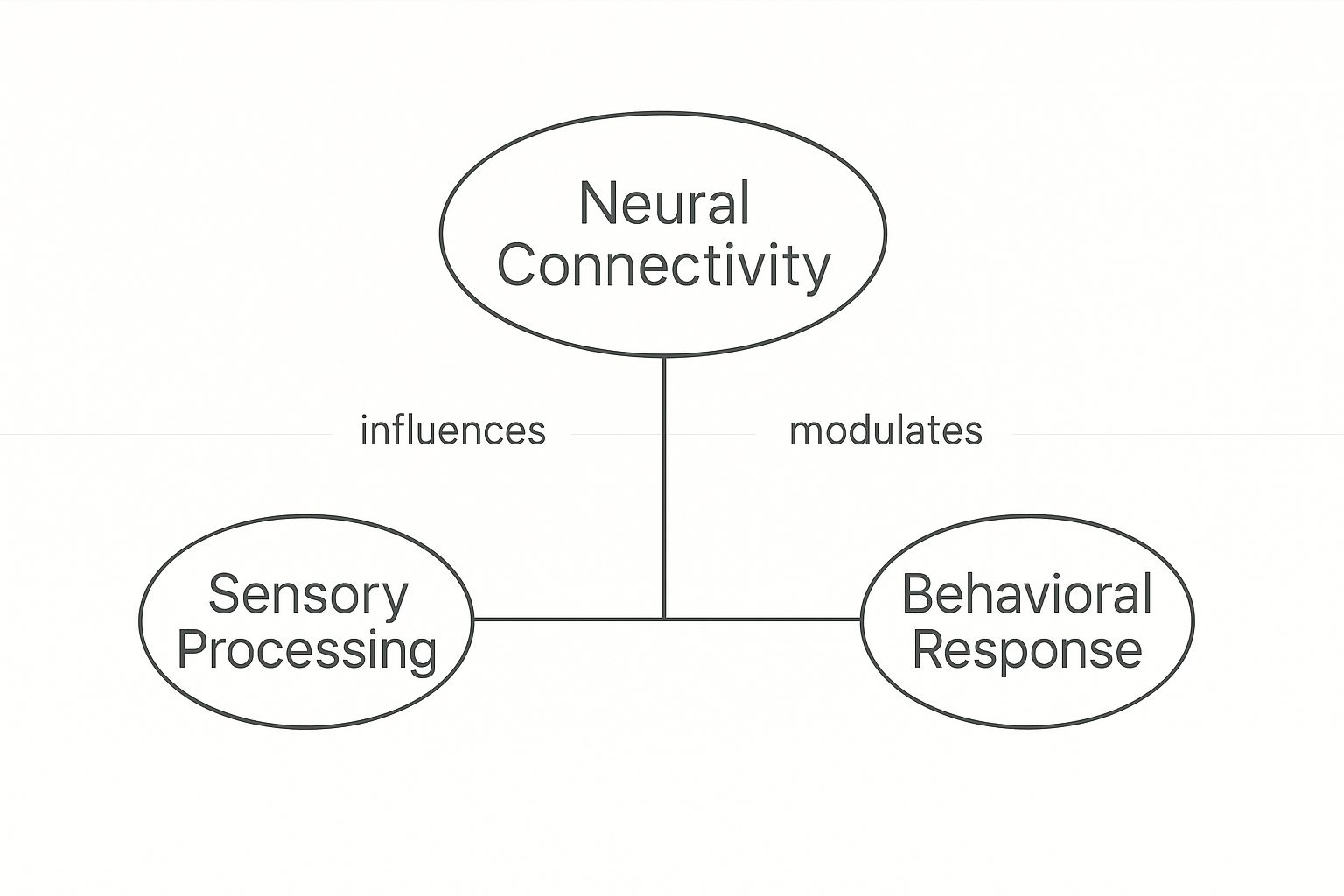
This map really drives home the point that what we see as behavior is often just the tip of the iceberg—a direct result of what's happening underneath with sensory processing and neural wiring.
A Growing Need for Understanding
The need for a deeper, neurological understanding of autism has never been more urgent. The prevalence of autism has increased significantly, highlighting just how many families are searching for answers.
Today in the United States, autism spectrum disorder affects approximately 1 in 31 children—a rate that's shot up nearly five times since the year 2000. For about 26.7% of these kids, their autism is considered 'profound,' which means they require substantial support right from a young age. This growing reality sets the stage for why we need effective strategies to support a dysregulated system.
The Gas Pedal Versus The Brake Pedal
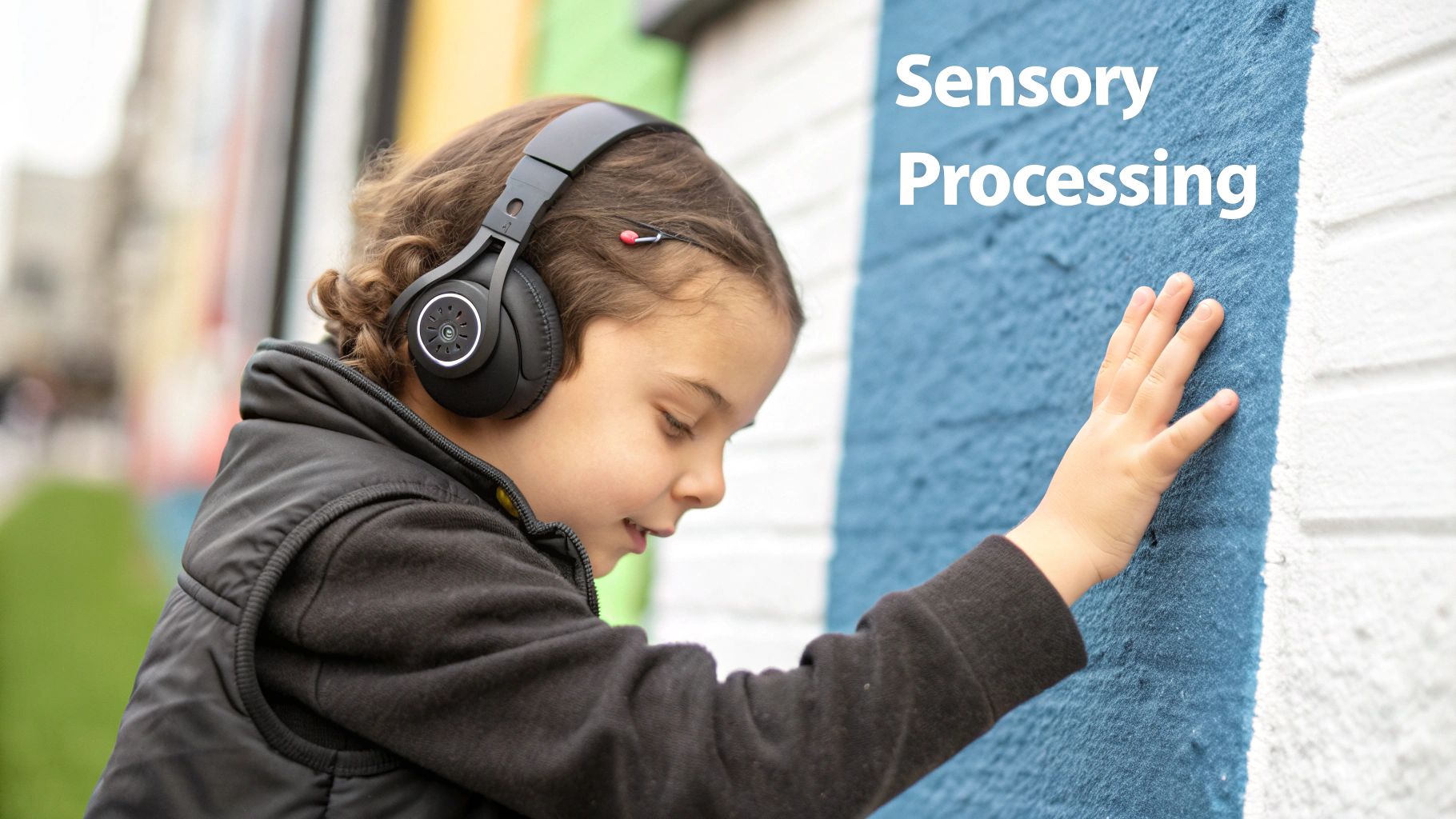
To really wrap our heads around the challenges an autistic nervous system faces, it helps to think of something we all understand: a car’s gas and brake pedals. Your sympathetic nervous system is the gas pedal. Its whole job is to rev the engine—getting you alert, ready for action, and geared up to handle stress.
On the flip side, the parasympathetic nervous system is the brake. This is what slows the car down, letting it rest, refuel, and run maintenance checks. It’s what brings on a sense of calm, helps with digestion, and allows the body to heal. In a healthy, well-regulated system, these two pedals work together beautifully, letting you speed up when you need to and slow down to recover.
When the Gas Pedal Gets Stuck
For so many kids and adults with autism, it’s as if that gas pedal is permanently jammed to the floor. This isn't a choice or a behavior; it's a physiological state where the body is stuck in high gear. We call this sympathetic dominance.
Imagine living in a state of constant high alert. The body is flooded with stress hormones, the muscles stay tight, and the brain is relentlessly scanning every single sight, sound, and sensation for potential danger. It’s exhausting, and it’s the neurological reason why the world can feel like such an overwhelming, intense place.
A nervous system stuck in sympathetic dominance is like having a fire alarm blaring nonstop. It becomes nearly impossible to focus on learning, connection, or rest because the body’s only priority is survival.
This neurological reality impacts millions of families. A huge 2024 meta-analysis that screened over 21 million children found that autism affects an estimated 0.77% of children globally. The data also reinforced a known gender disparity, with boys making up 1.14% of ASD diagnoses.
The Real-World Impact of Sympathetic Dominance
When the body's gas pedal is always on, the brake pedal—that crucial parasympathetic system—almost never gets a chance to do its job. This imbalance is what fuels so many of the challenges we associate with autism.
- Sensory Overwhelm: Bright lights, a loud room, or the tag on a shirt can feel physically painful. That’s because the nervous system is already maxed out and simply can't process one more piece of information.
- Emotional Meltdowns: A meltdown isn't a tantrum. It's the nervous system hitting a breaking point and short-circuiting from all the accumulated stress.
- Chronic Sleep Issues: To fall asleep and stay asleep, the body has to be able to hit the brakes. When the system is stuck in fight-or-flight, the brain can't power down, leading to restless nights and exhaustion.
- Digestive Problems: The parasympathetic state is often called "rest-and-digest" for a reason. When the body is in a constant stress response, digestion gets put on the back burner, which can lead to chronic stomach pain, constipation, and food sensitivities.
Seeing these connections is the first step. These aren't just a list of separate issues; they are all symptoms of an underlying nervous system that’s out of balance and stuck in overdrive. The key is to find gentle, effective ways to help the body finally apply the brakes. A great next step is learning more about parasympathetic nervous system stimulation, which is foundational to shifting from stress to calm and unlocking greater comfort, connection, and development.
How Spinal Misalignments Affect Neurological Signals
If the nervous system is the body’s superhighway, then neurological signals are the cars carrying vital information between the brain and every single cell. For this highway to work right, the road needs to be clear. But what happens when there's a major pile-up? This is where the physical structure of the spine becomes so critical.
Physical tension and misalignments in the spine—what we call vertebral subluxations—create interference in this communication network. Think of a subluxation as a significant traffic jam on that neurological highway. It doesn’t stop all the traffic, but it definitely slows things down, creates frustrating backlogs, and keeps messages from getting where they need to go on time and in the right order.
The Brainstem Connection
This interference becomes especially critical right at the top of the neck, where the spine meets the skull. This area protects the brainstem, which you can think of as the main traffic control center for the entire nervous system. It’s also where the all-important vagus nerve originates—the primary nerve that activates the body’s "brake pedal," or the parasympathetic calming response.
When a subluxation happens in this upper cervical area, it can directly irritate and interfere with how the brainstem and vagus nerve function. This disruption throws a wrench in the body's ability to switch from the high-alert "gas pedal" state to the calm "rest-and-digest" mode.
The image below shows how a misaligned vertebra can impact the surrounding nerves, creating that neurological traffic jam.
As you can see, the misalignment narrows the channel where the spinal nerve exits, creating pressure and disrupting the clear flow of signals. This physical stress is a huge piece of the puzzle for why an autism nervous system might struggle to find a state of calm.
What Causes These Neurological Traffic Jams?
These spinal misalignments and the nerve interference they cause don't just happen out of the blue. They are often the result of the body’s inability to adapt to different kinds of stress. We can usually trace them back to three main categories.
A subluxation isn’t just a bone out of place; it's a neurological signal jam that traps the body in a defensive, fight-or-flight posture, making regulation incredibly difficult.
This constant physical stress keeps the sympathetic system on high alert. For anyone looking to support an autism nervous system, understanding this link between the spine and nerve signals is fundamental. You can dive deeper into how gentle adjustments help restore balance by exploring the relationship between chiropractic and the nervous system.
The primary sources of stress that can lead to subluxation include:
- Physical Stress: This can start as early as birth trauma (from interventions like forceps, vacuum, or C-sections), or even from the common tumbles and falls of childhood.
- Chemical Stress: Exposure to toxins, inflammatory foods, or certain medications can trigger a stress response in the body that leads to physical tension and misalignment.
- Emotional Stress: High levels of anxiety, fear, or overwhelm—very common experiences for a dysregulated nervous system—can cause muscles to tighten up and pull the spine out of its proper alignment.
When these stressors pile up, they can lock the spine into a misaligned pattern, creating a vicious cycle of neurological interference. This just reinforces that "stuck on" gas pedal, making it even harder for the body to regulate itself, rest, and develop the way it’s meant to.
Alright, let's break this down. Once we understand how spinal misalignments can clog up the nervous system's communication lines, we can look at a gentle, targeted way to clear them up. This is where Neuro-Tonal Chiropractic care comes in.
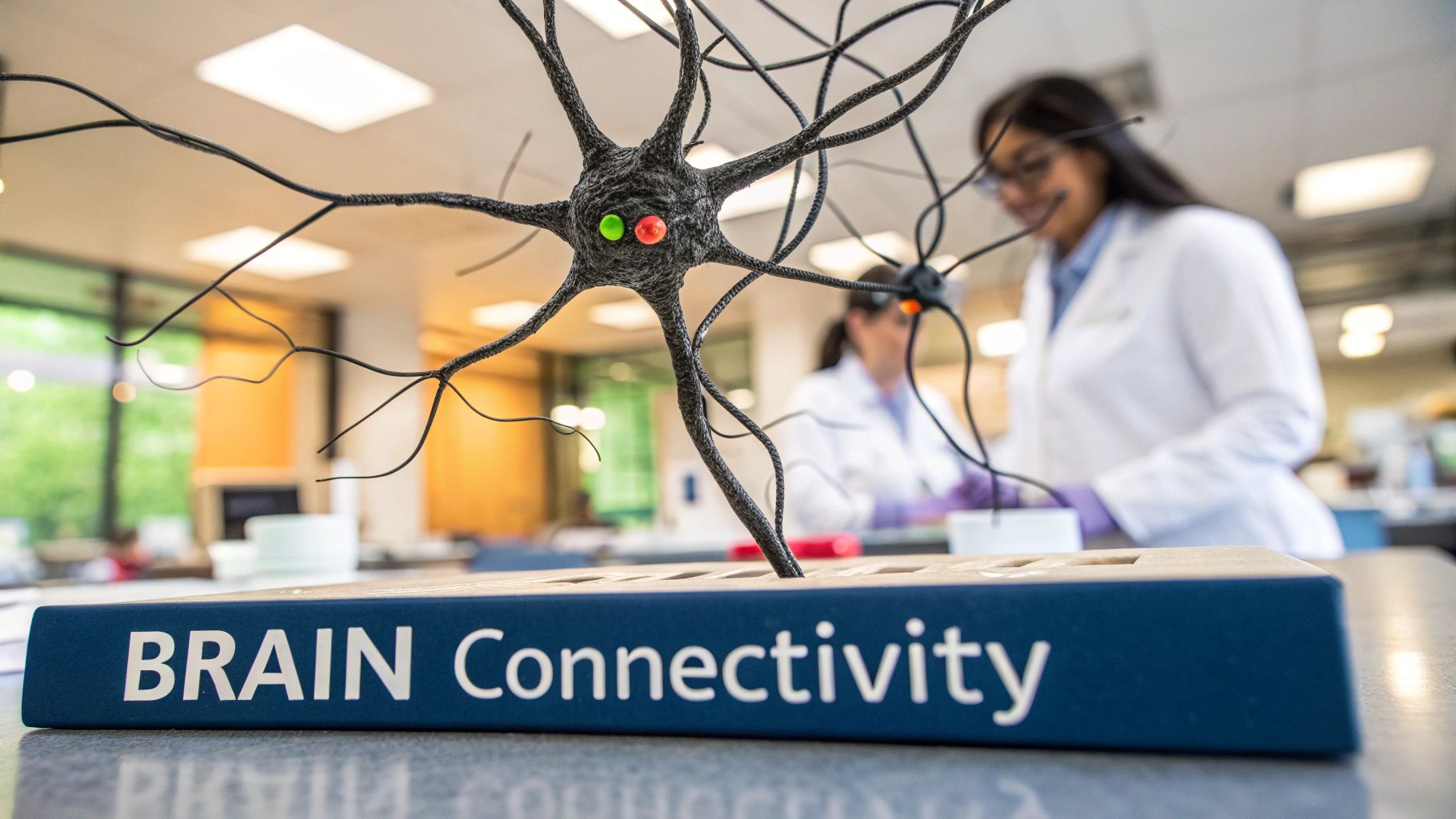
This approach works with the autism nervous system, not against it. It's so important to be clear about one thing: we are not treating or curing autism itself.
Our focus is entirely on the underlying nervous system dysregulation. The goal is to help the body release that stuck "gas pedal" and finally find its "brake pedal," allowing for a far more balanced and regulated state.
Gentle Adjustments to Restore Balance
First things first—Neuro-Tonal Chiropractic is nothing like the forceful "cracking" or "popping" many people imagine when they hear the word "chiropractor." The adjustments are incredibly gentle, specific, and precise. In fact, we often use no more pressure than you would to check if a tomato is ripe.
The goal is to gently clear those neurological traffic jams, especially in the upper neck where misalignments can most directly impact the brainstem and vagus nerve. By restoring proper alignment and motion, we take a huge amount of physical stress off the nervous system.
This gentle approach allows the body to shift out of its chronic defensive posture. It helps the nervous system feel safe enough to finally let go of the constant fight-or-flight response that drains resources and gets in the way of development.
This shift is everything when it comes to improving the overall tone of the nervous system.
Understanding Neurological Tone
When we talk about tone, we're referring to the resting state of the nervous system. A great analogy is the idle setting on a car’s engine. Is the engine constantly revving high, burning fuel even when it’s parked? Or is it humming along quietly, ready to accelerate when needed but calm and efficient at rest?
An autistic nervous system often has a high neurological tone—it's perpetually revved up and stuck in that sympathetic, high-alert mode. The main job of Neuro-Tonal Chiropractic is to help reset this tone to a more balanced, regulated state.
The core goals of this care are pretty straightforward:
- Releasing Stuck Stress: We gently unwind the physical tension patterns that keep the nervous system locked in a defensive, wound-up state.
- Improving Brain-Body Communication: We clear the interference so that signals between the brain and the body can flow freely and accurately again.
- Activating the Parasympathetic System: We help the body re-engage its "brake pedal"—the parasympathetic system—to promote rest, digestion, healing, and regulation.
This entire process helps the body rediscover its own innate ability to self-regulate and adapt to the world around it. It's about restoring function from the inside out, not just chasing symptoms.
How This Approach Supports Development
When the nervous system can finally access a state of calm more easily, the body can redirect its energy toward growth and development instead of just survival. This neurological reset creates a much stronger foundation for a child to truly thrive.
By getting to the root cause—a dysregulated autism nervous system—we open the door for improvements in all areas of life. The whole process is designed to be safe, gentle, and effective, providing the support that allows for better rest, regulation, healing, and connection. It’s all about helping a child’s nervous system find the balance it needs to unlock its full potential.
From Dysregulation to Balanced Development
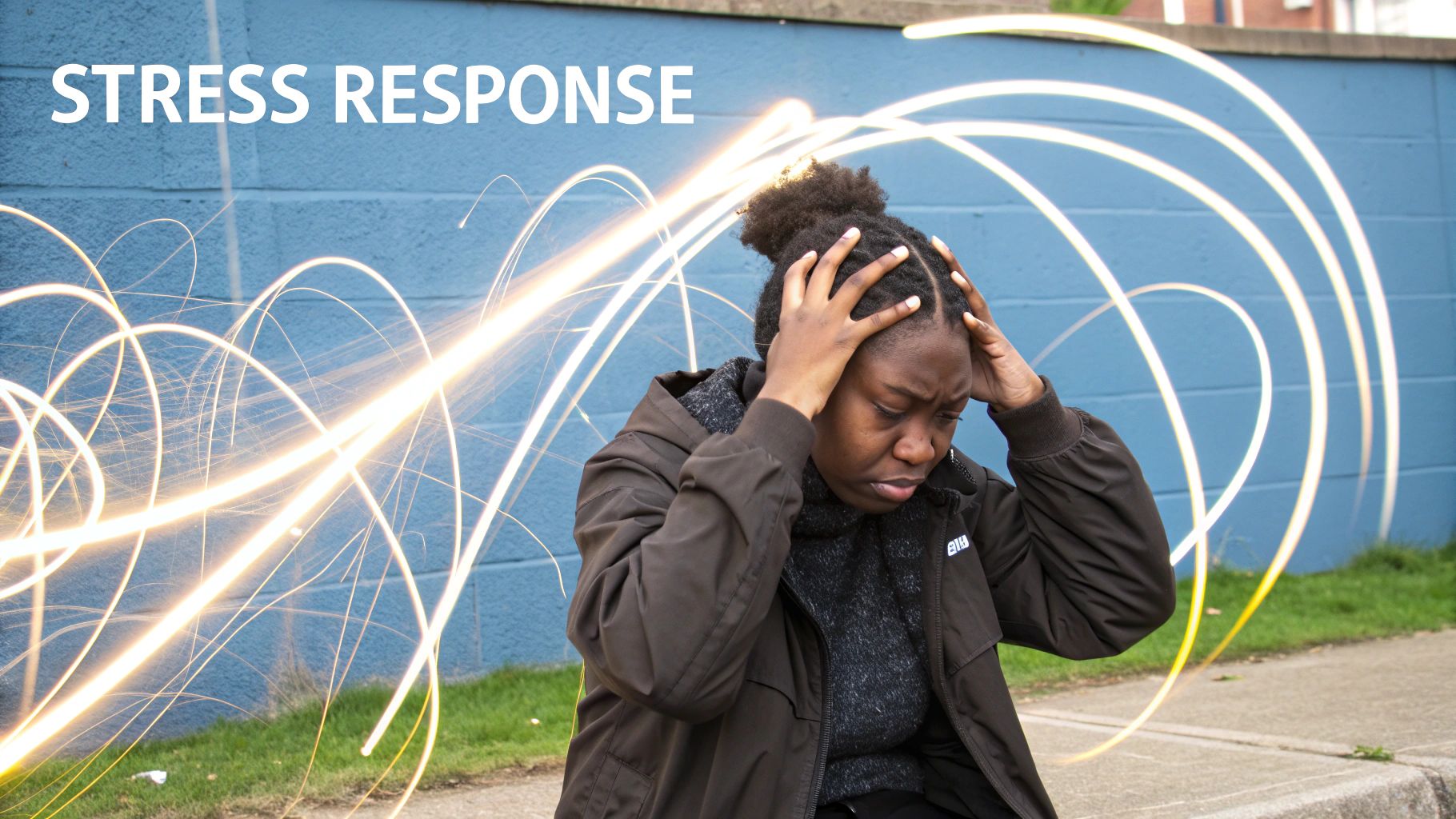
So, what actually happens when a nervous system stuck in overdrive finally gets to pump the brakes? It's a game-changer.
When that constant “fight-or-flight” alarm finally quiets down, the body can shift its precious energy away from just surviving and redirect it toward growth, connection, and healing. This move from a dysregulated state to a more balanced one is where we start seeing incredible, real-world changes in daily life.
It's so important to see these shifts for what they are. This isn't about "curing" autism. Instead, these are the beautiful, natural results of an autism nervous system that is finally supported and regulated. By dialing down the neurological noise, we help unlock the body’s amazing, built-in ability to adapt and thrive.
Observable Shifts Toward Regulation
When the parasympathetic “brake pedal” starts working like it should, the changes can feel profound. A child is no longer just getting through each moment; they are finally being given the neurological space to grow.
This often translates into noticeable improvements in areas that were once a constant source of struggle for the whole family. A calmer nervous system creates the foundation for a calmer, more connected household.
The goal is not to eliminate stress but to build a more flexible nervous system—one that can encounter a challenge, activate a response, and then successfully return to a state of calm and safety afterward.
Let’s get specific. Here are some of the most common areas where parents and caregivers see positive changes:
- Improved Sleep Quality: A body stuck on high alert simply can't power down for restful sleep. A regulated system, however, can finally enter those deep, restorative sleep cycles. This leads to better moods, improved focus, and more energy for learning and play.
- Enhanced Digestive Comfort: The "rest-and-digest" system can finally get back to work. For many kids, this means less chronic stomach pain, more regular bowel movements, and a reduction in the food sensitivities that are so common with a stressed-out system.
- Better Emotional Regulation: With the internal alarm bells turned down, a child has much more capacity to handle everyday frustrations. This often leads to fewer meltdowns—which are not tantrums, but neurological "short circuits" from being completely overwhelmed.
- Calmer Sensory Processing: When the nervous system isn't constantly scanning for threats, sensory information becomes less overwhelming. Sounds, lights, and textures that were once unbearable may now be manageable, or even enjoyable.
Real-World Scenarios of Change
These shifts aren't just theories on a page. They show up in real, everyday moments that can feel like miracles to a family that has been struggling.
Think about a little boy who used to dread family gatherings because the noise felt physically painful. After care focused on regulating his nervous system, he might now be able to go to a birthday party and happily watch from a quiet corner without a meltdown. He isn't "cured," but his system now has the capacity to manage that environment.
Or, picture a little girl who struggled with chronic constipation and stomach aches that affected her school attendance and her mood. As her nervous system shifts into a more parasympathetic state, her digestive system starts functioning properly. The physical relief allows her bright, happy personality to finally shine through. These are the powerful outcomes of a balanced autism nervous system.
To make this even clearer, the table below shows what this journey from a stressed state to a regulated one can look like.
Potential Shifts from a Dysregulated to a Regulated Nervous System
| Area of Challenge | Experience in a Dysregulated State (Sympathetic) | Potential Shift in a Regulated State (Parasympathetic) |
|---|---|---|
| Sensory Input | Lights feel blinding; sounds are painfully loud; touch is irritating. | Able to tolerate a wider range of sensory experiences without distress. |
| Sleep | Difficulty falling asleep; frequent waking; never feels rested. | Falls asleep more easily and stays asleep longer for restorative rest. |
| Social Interaction | Overwhelming and anxiety-provoking; leads to shutdowns or meltdowns. | Increased capacity for engagement, connection, and social learning. |
| Digestion | Chronic constipation, diarrhea, or stomach pain; picky eating. | Regular, comfortable digestion and a greater willingness to try new foods. |
Seeing these potential changes laid out side-by-side helps illustrate the profound impact that nervous system regulation can have on a child's quality of life. By supporting the body's foundational operating system, we open the door to progress in every other area of development.
Building a Foundation for Other Therapies
Neuro-tonal chiropractic care isn’t meant to be an isolated solution. Think of it as a crucial foundational piece in a larger, supportive puzzle. By focusing on regulating the autism nervous system, we can create a much stronger platform for other essential therapies to build upon. It’s all about preparing the body and brain to be more receptive to growth, connection, and learning.
Imagine trying to teach a student in a classroom while a fire alarm is blaring nonstop. It would be nearly impossible for them to focus, absorb information, or engage with the lesson. When a child’s nervous system is stuck in that protective “fight-or-flight” mode, their brain is dealing with that same kind of constant, internal alarm.
This is why therapies like occupational, speech, or behavioral therapy can sometimes feel like such an uphill battle. If a child’s system is completely overwhelmed and defensive, their capacity to learn new skills, practice communication, and build connections is understandably limited.
Creating Capacity for Connection and Learning
Gently clearing interference within the nervous system helps to turn down that internal alarm. When a child can more easily access their “rest-and-digest” parasympathetic state, their brain is no longer consumed by survival instincts. It can finally redirect its energy and resources toward higher-level functions.
This newly regulated state can amplify the benefits of other supports:
- Occupational Therapy: A calmer nervous system can better process sensory input. This makes activities that once caused distress far more manageable and productive.
- Speech Therapy: With less internal stress, a child may have more neurological resources available for communication, engagement, and developing oral-motor skills.
- Behavioral Therapy: A regulated child is better equipped to manage their emotions and impulses, which leads to more successful implementation of new behavioral strategies.
By addressing the physiological state first, we create fertile ground for developmental and therapeutic progress. A regulated nervous system is a ready-to-learn nervous system.
An Empowered Approach for Families
Focusing on the health of the nervous system is a powerful, proactive step for parents and caregivers. However, this journey often intersects with much broader societal challenges. It’s a stark reality that for many, managing the autism nervous system is made even harder by difficulties in accessing care. In the U.S., approximately 11% of children with autism do not receive the healthcare they need, and many families face significant social and economic hurdles. You can discover more about these challenges and the push for better support systems.
Addressing nervous system dysregulation offers a path toward empowerment. By making the body a safer, more comfortable place to be, you build a resilient foundation for your child. This approach supports not just developmental progress but also fosters greater comfort, deeper connection, and a better quality of life for the entire family.
Frequently Asked Questions
When you're exploring different ways to support your child, it's natural to have a lot of questions. We've put together some answers to the most common things parents ask us about the autism nervous system and our neuro-tonal approach.
Our goal is to give you clear, straightforward information so you can feel confident and empowered in the decisions you make for your family's health.
Is This Type of Chiropractic Care Safe for Children?
This is always the first and most important question, and we're happy to say the answer is a definite yes. Neuro-tonal chiropractic adjustments for kids and babies are incredibly gentle, safe, and precise. We don't use any of the forceful twisting or "cracking" you might associate with adult chiropractic care.
The amount of pressure we use is often no more than what you'd use to check if a tomato is ripe. The whole idea is to work with your child's body to gently release tension and restore balance, not force anything. It's a soft, honoring approach designed for their delicate nervous system.
The focus is on gentle, specific contacts that help the body unwind stored stress. This process calms the nervous system, allowing it to move out of a state of constant defense and into one of growth and healing.
This commitment to safety and precision means our care is both comfortable and effective, even for the most sensitive little ones in your family.
What Should We Expect During a First Visit?
Your first visit with us is all about discovery. We'll start with a detailed conversation to fully understand your child's health journey and what you hope to achieve. A core part of this first appointment is our Insight Scans, which are completely non-invasive and use advanced technology to measure the amount of stress and tension held in the nervous system.
These scans give us a clear, objective picture of how your child's nervous system is functioning. They let us see exactly where the interference is without any guesswork. The whole process is simple, painless, and gives us the data we need to create a care plan that’s just for your child.
How Does This Fit with Other Therapies?
We see neuro-tonal chiropractic care not as an alternative to other therapies, but as a foundation that helps them work even better. By helping to regulate the autism nervous system, we create a calmer, more organized state where a child is more available for learning and development.
When the nervous system is more balanced, it can make a huge difference in other supportive therapies:
- Occupational Therapy: A child with a regulated system can process sensory information more effectively, making OT sessions far more productive.
- Speech Therapy: When neurological function improves, so does a child's ability to engage, communicate, and pick up new skills.
- Behavioral Therapy: A child who isn't stuck in a "fight-or-flight" state has a much greater capacity for emotional regulation and learning new behaviors.
Our approach is designed to be a collaborative part of your child’s entire support team, helping them get the absolute most out of every single effort.
At First Steps Chiropractic, we are passionate about helping families understand and support the nervous system. If you're ready to see what a gentle, neurologically-focused approach could do for your child's health and development, we invite you to schedule a complimentary consultation. You can learn more about our process and how we can help.
